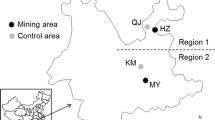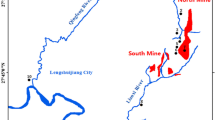Abstract
Continuous exposure of chemicals could cause various environmental impacts. Decabromodiphenyl ether (BDE209) and lead (Pb) can co-exist and are discharged simultaneously at e-waste recycling sites (EWRSs). Extensive concerns have been attracted by their toxic effects on soil microorganisms. Thus, by using high-throughput sequencing, this study explored bacterial community responses in a soil system after repeated Pb exposure in the presence of BDE209 in the laboratory during 90-day indoor incubation period. Gene sequencing of 16S rDNA performed on an Illumina MiSeq platform proved that one-off Pb exposure caused higher microbial abundance and community diversity. Additionally, both repetitive Pb treatment and exogenous BDE209 input could change bacterial community composition. Twenty-three different bacterial phyla were detected in the soil samples, while more than 90% of the sequences in each treatment belonged to a narrow variety. The sequence analyses elucidated that Proteobacteria, Acidobacteria, and Bacteroidetes were the top three dominant phyla. Our observations could provide a few insights into the ecological risks of Pb and BDE209 co-existed contamination in soils at EWRSs.






Similar content being viewed by others
References
Chou HL, Chang YT, Liao YF, Lin CH (2013) Biodegradation of decabromodiphenyl ether (BDE-209) by bacterial mixed cultures in a soil/water system. Int Biodeterior Biodegrad 85:671–682
Deng D, Tam NF (2015) Isolation of microalgae tolerant to polybrominated diphenyl ethers (PBDEs) from wastewater treatment plants and their removal ability. Bioresour Technol 177:289–297
Fierer N, Bradford MA, Jackson RB (2007) Toward an ecological classification of soil bacteria. Ecology 88:1354–1364
Gump BB, Yun S, Kannan K (2014) Polybrominated diphenyl ether (PBDE) exposure in children: possible associations with cardiovascular and psychological functions. Environ Res 132:244–250
Hendershot W, Lalande H, Duquette M (1993) Ion exchange and exchangeable cations. Soil sampling and methods of analysis. 19:167–176
Jez E, Lestan D (2015) Prediction of blood lead levels in children before and after remediation of soil samples in the upper Meza Valley, Slovenia. J Hazard Mater 296:138–146
Jones DL, Willett VB (2006) Experimental evaluation of methods to quantify dissolved organic nitrogen (DON) and dissolved organic carbon (DOC) in soil. Soil Biol Biochem 38:991–999
Jones RT, Robeson MS, Lauber CL, Hamady M, Knight R, Fierer N (2009) A comprehensive survey of soil acidobacterial diversity using pyrosequencing and clone library analyses. ISME J 3:442–453
Kalyuzhnaya MG, Bowerman S, Lara JC, Lidstrom ME, Chistoserdova L (2006) Methylotenera mobilis gen. nov., sp nov., an obligately methylamine-utilizing bacterium within the family Methylophilaceae. Int J Syst Evol Microbiol 56:2819–2823
Kim YM, Nam IH, Murugesan K, Schmidt S, Crowley DE, Chang YS (2007) Biodegradation of diphenyl ether and transformation of selected brominated congeners by Sphingomonas sp PH-07. Appl Microbiol Biotechnol 77:187–194
Kong AY, Scow KM, Córdovakreylos AL, Holmes WE, Six J (2011) Microbial community composition and carbon cycling within soil microenvironments of conventional, low-input, and organic cropping systems. Soil Biol Biochem 43:20–30
Langford K, Scrimshaw M, Lester J (2007) The impact of process variables on the removal of PBDEs and NPEOs during simulated activated sludge treatment. Arch Environ Contam Toxicol 53:1–7
Ligi T, Oopkaup K, Truu M, Preem JK, Nõlvak H, Mitsch WJ, Ülo M, Truu J (2014) Characterization of bacterial communities in soil and sediment of a created riverine wetland complex using high-throughput 16S rRNA amplicon sequencing. Ecol Eng 72:56–66
Meijer SN, Harner T, Helm PA, Halsall CJ, Johnston AE, Jones KC (2001) Polychlorinated naphthalenes in U.K. soils: time trends, markers of source, and equilibrium status. Environ Sci Technol 35:4205–4213
Niu X, Liu C, Song X (2015) Simulation research on the natural degradation process of PBDEs in soil polluted by e-waste under increased concentrations of atmospheric O3. Chemosphere 118:373–382
Peralta RM, Ahn C, Gillevet PM (2013) Characterization of soil bacterial community structure and physicochemical properties in created and natural wetlands. Sci Total Environ 443:725–732
Pruesse E, Quast C, Knittel K, Fuchs BM, Ludwig W, Peplies J, Glöckner FO (2007) SILVA: a comprehensive online resource for quality checked and aligned ribosomal RNA sequence data compatible with ARB. Nucleic Acids Res 35:7188–7196
Qian P-Y, Wang Y, Lee OO, Lau SCK, Yang J, Lafi FF, Al-Suwailem A, Wong TYH (2011) Vertical stratification of microbial communities in the Red Sea revealed by 16S rDNA pyrosequencing. ISME J 5:568–568
Quan SX, Yan B, Yang F, Li N, Xiao XM, Fu JM (2015) Spatial distribution of heavy metal contamination in soils near a primitive e-waste recycling site. Environ Sci Pollut Res 22:1290–1298
Robrock KR, Mohn WW, Eltis LD, Alvarez-Cohen L (2011) Biphenyl and ethylbenzene dioxygenases of rhodococcus jostii RHA1 transform PBDEs. Biotechnol Bioeng 108:313–321
Roesch LF, Fulthorpe RR, Riva A, Casella G, Hadwin AK, Kent AD, Daroub SH, Camargo FA, Farmerie WG, Triplett EW (2007) Pyrosequencing enumerates and contrasts soil microbial diversity. ISME J 1:283–290
Rousk J, Bååth E, Brookes PC, Lauber CL, Lozupone C, Caporaso JG, Knight R, Fierer N (2010) Soil bacterial and fungal communities across a pH gradient in an arable soil. ISME J 4:1340–1351
Schloss PD, Westcott SL, Ryabin T, Hall JR, Hartmann M, Hollister EB, Lesniewski RA, Oakley BB, Parks DH, Robinson CJ (2009) Introducing mothur: open-source, platform-independent, community-supported software for describing and comparing microbial communities. Appl Environ Microbiol 75:7537–7541
Shen C, Chen Y, Huang S, Wang Z, Yu C, Qiao M, Xu Y, Setty K, Zhang J, Zhu Y (2009) Dioxin-like compounds in agricultural soils near e-waste recycling sites from Taizhou area, China: chemical and bioanalytical characterization. Environ Int 35:50–55
Smolders E, Oorts K, Peeters S, Lanno R, Cheyns K (2015) Toxicity in lead salt spiked soils to plants, invertebrates and microbial processes: unraveling effects of acidification, salt stress and ageing reactions. Sci Total Environ 536:223–231
Tang XJ, Shen CF, Lei C, Xi X, Wu JY, Khan MI, Dou CM, Chen YX, Xu JM, Tang CX (2010) Inorganic and organic pollution in agricultural soil from an emerging E-waste recycling town in Taizhou area, China. J Soils Sediments 10:895–906
Tian W, Wang L, Li Y, Zhuang K, Li G, Zhang J, Xiao X, Xi Y (2015) Responses of microbial activity, abundance, and community in wheat soil after three years of heavy fertilization with manure-based compost and inorganic nitrogen. Agric Ecosyst Environ 213:219–227
Wang Y, Qian PY (2009) Conservative fragments in bacterial 16S rRNA genes and primer design for 16S ribosomal DNA amplicons in metagenomic studies. PLoS One 4:e7401
Wang F, Wang J, Dai J, Hu G, Wang J, Luo X, Mai B (2010) Comparative tissue distribution, biotransformation and associated biological effects by decabromodiphenyl ethane and decabrominated diphenyl ether in male rats after a 90-day oral exposure study. Environ Sci Technol 44:5655–5660
Wu K, Xu X, Liu J, Guo Y, Li Y, Huo X (2010) Polybrominated diphenyl ethers in umbilical cord blood and relevant factors in neonates from Guiyu, China. Environ Sci Technol 44:813–819
Xiao E, Krumins V, Tang S, Xiao T, Ning Z, Lan X, Sun W (2016) Correlating microbial community profiles with geochemical conditions in a watershed heavily contaminated by an antimony tailing pond. Environ Pollut 215:141–153
Yang H, Huo X, Yekeen TA (2013) Effects of lead and cadmium exposure from electronic waste on child physical growth. Environ Sci Pollut Res 20:4441–4447
Zhang S, Xu X, Wu Y, Ge J, Li W, Huo X (2014) Polybrominated diphenyl ethers in residential and agricultural soils from an electronic waste polluted region in South China: distribution, compositional profile, and sources. Chemosphere 102:55–60
Zhang R, Zhang W, Liu G, Lin K, Fu R (2016a) Changes of lead speciation and microbial toxicity in soil treated with repeated Pb exposure in the presence of BDE209. Environ Sci Pollut Res 23:4621–4628
Zhang W, Chen L, Zhang R, Lin K (2016b) High throughput sequencing analysis of the joint effects of BDE209-Pb on soil bacterial community structure. J Hazard Mater 301:1–7
Zheng S, Zhang M (2011) Effect of moisture regime on the redistribution of heavy metals in paddy soil. J Environ Sci 23:434–443
Zhong WH, Cai ZC (2007) Long-term effects of inorganic fertilizers on microbial biomass and community functional diversity in a paddy soil derived from quaternary red clay. Appl Soil Ecol 36:84–91
Zhu W, Liu L, Zou P, Xiao L, Yang L (2010) Effect of decabromodiphenyl ether (BDE 209) on soil microbial activity and bacterial community composition. World J Microbiol Biotechnol 26:1891–1899
Zhu D, Tanabe SH, Yang C, Zhang W, Sun J (2013) Bacterial community composition of South China Sea sediments through pyrosequencing-based analysis of 16S rRNA genes. PLoS One 8:528–534
Funding
The research was supported by the National Natural Science Foundation of China (41877124, 21737005, 51708223) and the Science and Technology Committee Research Program of Shanghai (17DZ1202304, 18DZ1204403).
Author information
Authors and Affiliations
Corresponding authors
Additional information
Responsible editor: Robert Duran
Rights and permissions
About this article
Cite this article
Liu, B., Zhang, R., Xia, X. et al. Toxicity responses of bacterial community as a biological indicator after repeated exposure to lead (Pb) in the presence of decabromodiphenyl ether (BDE209). Environ Sci Pollut Res 25, 36278–36286 (2018). https://doi.org/10.1007/s11356-018-3342-y
Received:
Accepted:
Published:
Issue Date:
DOI: https://doi.org/10.1007/s11356-018-3342-y




